Indian puppetry tradition is remarkably known for its abundant traditional ethos and cultural embeddedness. This art is the melting pot of painting, literature, dance, music, sculpture, and drama. Puppetry resonates and beautifully varies temporally and spatially across the Indian subcontinent—with the inceptional puppetry originating in pre-Vedic times. To a novice newly engulfed by the enormity of heritage in puppetry, every regional puppetry appears to have a similar prototype of stories, personified characters, and folklore. However, there are myriad varieties of puppetry practiced in India such as string puppets, shadow puppets, glove puppets, and rod puppets. In Natya Shastra, wherein they find their initial roots, puppets are closely aligned with fields of technical design, crafting, movements, and ornamentation. Today, stories or embellishments of puppets are arduous to visually perceive by modern society. It is the desideratum of the hour to ascertain the puppet structure as well as revive it in its traditional forms and efficiently perpetuate the centuries-old tradition of storytelling about our opulent tradition.
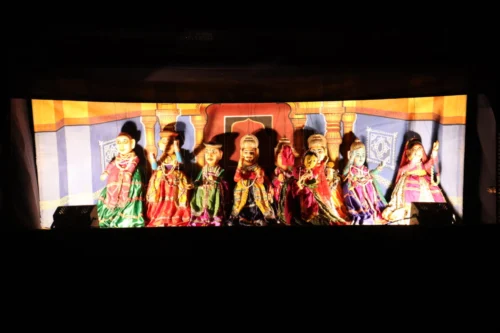
Amongst the waves and verdant of Sindhudarg, Maharashtra dwells a legacy carried on by the Thakar community referred as ‘Kalasutri Bahulya’ i.e. string puppetry. This art form has been performed by Thakar tribes in Maharashtra for over half a millenium. According to a recurring narrative, Chhatrapati Shivaji Maharaj once asked a tribal person, Vishram Gangavane, to engage in espionage for the kingdom because he was a wandering musician who visited every house. However, over time, the focus of Thakar artists shifted away. When Parshuram Gangavane saw the art form fading away, he worked hard to save it, and transformed his cowshed into a museum to rejuvenate Kalasutri Bahulya.
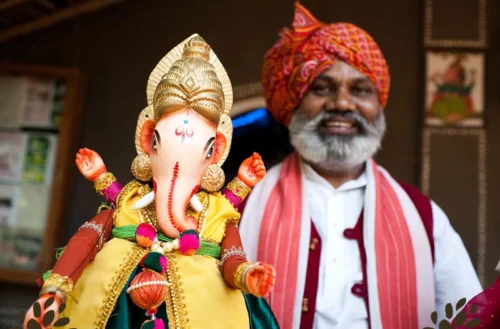
Historical Origins
Puppets, in India, have been the forebearer of not just local entertainment but a carrier of niche cultural and religious traditions. Etymologically, ‘Kalasutri’ consists of two parts, ‘Kala’ and ‘Sutri’ which signify ‘fingertip’ and ‘string’ respectively. ‘Bahulya’ signifies the ‘puppet.’ The puppets, carved from furniture woods for durability, are fastened with strings to enunciate movement. The tales typically enacted are from the Ramayana and Mahabharata. It is also called as Zaiti, a Marathi art form.
The Kalasutri puppets are mentioned in the fifteenth chapter of the renowned and sacred text ‘Gyaneshwari,’ authored by Sant Gyaneshwar. These Kalasutri string puppets came from the Rajasthan-Gujarat belt before they were brought to Maharashtra, wherein, they acquired support from the rulers of Sawantwadi. Sawantwadi is the one of the last major towns of Maharashtra before reaching the Goa border. This place, historically, was ruled by the Bhonsle dynasty, which was extremely popular for its affinity to preserve traditional arts and crafts. Kudal, in the Sindhudurg district, is located twenty kilometers from Sawantwadi. Pinguli, situated ten kilometers from the town of Sindhudurg and known as the puppetry village, has been the abode to traditional folk artists, or praramparik kalakars, since the middle of the eighteenth century.
Apogee and Cultural Effervescence
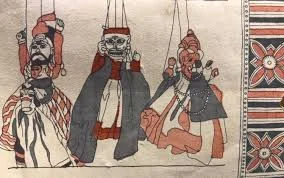
Nowadays, string puppets have nearly vanished from the mainstream culture and are only found among the aforementioned Thakars of Maharashtra. However, the puppetry is culturally effervescent and performed with great intricacy. The string puppets are made out of wood and adorned with remarkable attire to show gods, demons, kings, and mythical beings, reflecting a distinct style and colour palette. The shadow puppets, on the other hand, are different from string puppets and are crafted from leather which is thinned and converted into intricate designs portraying various characters. Images are illustrated on handmade paper, with one image’s back adhered to another in a manner that creates a front-and-back appearance.
The puppeteers portray 1.5-foot-tall string puppets carved from wood and adorned with vibrant attire to resonate the ethos of Indian epics and folk tales. These puppets are showcased as mythological figures like: kings, devils, and slaves. The strings used to operate the puppets resemble those utilized for sandal repairs, noted for their flexibility and resilience. Each puppet typically employs three strings: one connects to the head, and two facilitate hand movements. These strings are linked to a stick that is managed by the puppeteer, with hand actions producing the required movements of the puppets.
Traditional Aestheticisation of Visual Storytelling
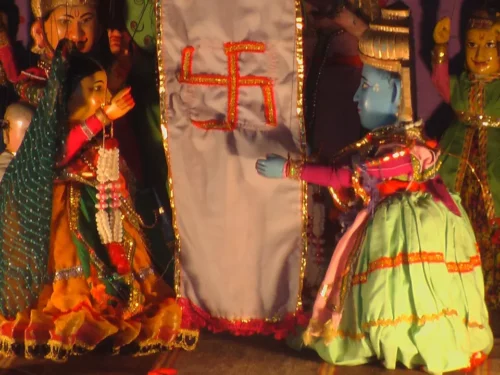
Kalasutri Bahulya performances are inspired from the epics of Hinduism and Puranas. Purva Ranga, the opening segment of each show, features elaborate rituals and initiation ceremonies performed with adorned puppets of the gods Ganesha, Shiva, and Saraswati. While a musician plays instruments like the tabla (drum), conch, chakava (cymbals), and tuntuni (drone), an assistant narrates and sings the story during the puppetry performance. The Nayaki, or lead artist, who plays the table, oversees the whole performance, alongside other musicians positioned outside of the puppet box. Within the puppet box, the puppeteers, referred to as Sutradhars, control the puppets.
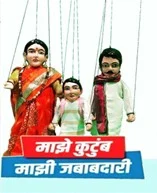
The songs also feature early folk tunes along with lores by modern saint poets. Various narratives have been depicted, such as the worship of Lord Ganesha and Goddess Saraswati. There are also references to Riddhi-siddhi, Mahadev, a clown, a thief, a traveler, King Dasharatha, and episodes from the Ramayana. For instance, rakshasa and rakshasi of Ravana in Ramayana are portrayed with enunciated, angry mouth movements. Characters predominantly drawn from Hindu mythology are utilized. Pinguli Thakar not only showcases mythological tales within tribal contexts but also addresses modern issues through Loka-Kaka. They aim to engage with the audience regarding current social and political matters like Kutumb Mazi Jabdari (My family is my responsibility).
Modern Impacts and a Retrograde Phenomenon
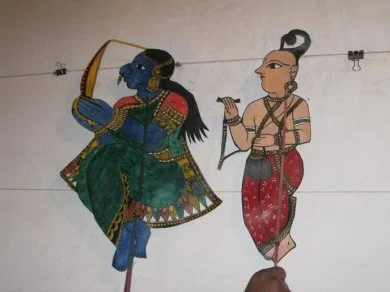
This fascinating element of the traditional cultural realm, in hindsight, is declining in the decades from the 1970s due to myriad evolutionary factors. Puppeteer Ganapat Sakharam Masge enacts puppeteering variants and performances across the Indian subcontinent. During these times of cognitive lethargy, huge technological addiction and dependency — recreation through art forms like Kalasutri Bahulya is bound to rejuvenate the mind. The Thakar family actively cherishing this Puppetry art laments the exile of youth to metropolitan cities without learning judiciously about their own community heritage.
The lack of patronage or support from the society makes the practitioners lose faith in their ancestral art form. With the normalisation of digital modes like Television and Mobile Phone, entertainment has been commodified for commercial or extravagant purposes. The raw and authentic exuberance exerted by Kalasutri Bahulya and Indian puppetry traditions is unparalleled and its continuity ought to be prioritised in this age of acceleration.
References:
MAP Academy. (2023, December 8). Kalasutri Bahulya – MAP Academy. https://mapacademy.io/article/kalasutri-bahulya/
Article – Kalasutri Bahuliya: A dying puppetry art of Maharashtra – Charanya Gurusathya. (n.d.). https://narthaki.com/info/articles/art389.html
Agase, D. (2022). The Traditional Lok-kala Of Storytelling Kalsutri Bahulya (Puppets) from Maharashtra. Vit-in. https://www.academia.edu/93969891/The_Traditional_Lok_kala_Of_Storytelling_Kalsutri_Bahulya_Puppets_from_Maharashtra
EscapingsoulIn, S. V. (n.d.). Pinguli’s Puppetry that preserves the dying art of Maharashtra. Tripoto. https://www.tripoto.com/maharashtra/trips/pingulis-puppetry-that-preserves-the-dying-art-of-maharashtra-5f27e2bf7116a
Pandey, A. (2017). PUPPETRY-THE TRADITIONAL FOLK THEATRE OF INDIA. Zenodo (CERN European Organization for Nuclear Research). https://doi.org/10.5281/zenodo.265331




